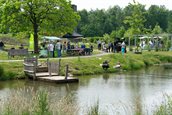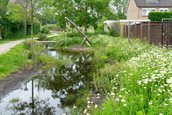Wensink-Zuid adventure island helps combat waterlogging in Borne
In the Wensink-Zuid district, the municipality of Borne has created a climate-adaptive adventure island using funds from the national government incentive scheme. The adventure island is located along bicycle highway F35 and the Borne-Hengelo railway track. This large play area for children can collect rainwater in order to prevent waterlogging. The island features extensive new greenery and offers plenty of room for local children to play, as well as meeting places for grown-ups.

What has prompted the Wensink-Zuid project?
The 1960s district had several roads that needed replacement. The roadworks provided the municipality with the opportunity to tackle rainwater discharge and prevent waterlogging. The goal was for rainwater to be collected locally, in order to reduce the volume of water flowing into the sewer system. The municipality of Borne's water and greenery departments were involved in the project, and Te Kiefte Architects was responsible for the design. Residents could vote for the design they liked best. Welbions housing corporation and the Wensink-Zuid district committee also participated in the project.
Underground basement for bats
Part of the premises of the former Stella Maris school complex had already been converted into a water storage area for the fire brigade to use. The new adventure island has boosted its rainwater collection capacity. During the construction of the island, a decision needed to be made regarding the old Stella Maris school building, which at that time served as housing for immigrants on temporary admission. Considering the building’s bad state of repair and the high costs of energy, the municipality decided to tear the building down. An additional challenge was posed by the bat population that had nestled in the building: the province demanded that the bats currently residing there needed to stay. For that reason, the municipality preserved the underground school basement, providing a safe habitat for the bats.
Special playground equipment
A range of special playground equipment has been provided on the adventure island, such as a rope ferry to cross the retention pond. A swing rope hangs above the bioswale, and a water pump lets children play with sand and water. In addition, the island features a swing, a hill slide and a playhouse for younger children. Wherever possible, old materials have been recycled, such as pavement stones for the seating areas and the partitions. The old steel poles of the school bicycle shed have been retained and are now covered in ivy, providing shade and cooling during hot periods of time. The soil that was excavated to collect water has been used to create and raise the adventure island.

Green lung
The greenery in this area mainly consisted of a large lawn and a few trees. A huge amount of additional greenery was planted on the adventure island. The municipality has opted for indigenous plants and bushes wherever possible. This green lung serves as a catchment area for water from the surrounding streets to drain into. Ecological management of the greenery by the municipality boosts biodiversity. Te Kiefte Architects intended for the adventure island to become the beating heart of the district and has therefore created a central meeting area with a heart-shaped design.
Fruit hedge and forest garden
Furthermore, a fruit hedge and a forest garden have been planted, producing edible fruits. The fruit hedge consists of white currants, redcurrants, blackcurrants, wineberries, elderberries, loganberries and gooseberries. The forest garden features old Dutch apple species, quinces, cherries, medlars, plums, eating pears and cooking pears.
Positive reactions
Local residents are very happy with the adventure island. As one resident put it: “What a beautiful place you have created!’ According to a local mum, her children are reluctant to go home when playing there. Other municipalities have come by to gain inspiration. A point for attention, however, are loitering teens. The municipality has initiated a pilot project involving several youth hangout places (JOPs in Dutch), with charging stations and Wi-Fi. Along with youth work departments, the police and municipal enforcement bodies, the municipality is setting up a programme for creating appealing, supervised hangouts.
Incentive scheme grant
This project has been co-funded with a EUR 115,925 grant from the East-Netherlands Freshwater Supply Incentive Scheme.
Contact person
Stef van Wanrooij
Gemeente Borne
s.vanwanrooij@borne.nl